Comfort Women
 From Nwe
From Nwe | Comfort women | |
|---|---|
| Chinese name | |
| Traditional Chinese: | 慰安婦 |
| Simplified Chinese: | 慰安妇 |
| Hanyu Pinyin: | Wèiān Fù |
| Wade-Giles: | Wei-An Fu |
| Korean name | |
| Hangul: | 위안부 |
| Hanja: | 慰安婦 |
| Revised Romanization: | wianbu |
| McCune-Reischauer: | wianbu |
Comfort women (Japanese: 慰安婦 ianfu) or military comfort women (Japanese: 従軍慰安婦 jūgun-ianfu), a euphemism for the up to 200,000 women who were forced to serve in the Japanese army's brothels during World War II. Historians and researchers into the subject have stated that the majority came from Korea, China and other occupied territories, recruited by force or deception to serve as "sex slaves."[1][2][3]
Japan's justification for abducting Korean, Chinese, and Southeast Asians to serve as Comfort women in military Comfort Stations throughout the Japanese theater during World War II lay in the desire to meet their warriors every need to win in battle. During the 1930s, the Samurai-Shinto faction defeated the humanistic-spiritual faction in Japan, creating a militaristic society that led Japan into the catastrophic Pacific theater of World War II. Unfortunately, the deeds of the military faction leading up to and during World War II await believable repudiation by the current Japanese government.
Overview
Some Japanese historians, using the diaries and testimony of military officials as well as official documents from the United States and other countries, have argued that the Imperial Japanese Army and Navy directly or indirectly coerced, deceived, lured, and sometimes kidnapped young women throughout Japan’s Asian colonies and occupied territories.[4] Evidence supporting accounts of abuse by the Japanese military—includes the kidnapping of women and girls for use in the brothels, testimony by witnesses, victims, and former Japanese soldiers.[5] Much of the testimony from self-identified victims state that Japanese troops kidnapped and forced them into sexual slavery and historians have said evidence discovered in Japanese documents in 1992 show that Japanese military authorities had a direct role in working with contractors to forcibly procure women for the brothels.[6]
Some historians, researchers, and politicians, mostly from Japan, have argued the evidence supporting sexual slavery within the Imperial Japanese military is weak or nonexistent. They deny that the Japanese military participating, either directly or indirectly, in recruiting or placing women in brothels frequented by Japanese military servicemen.[7] Japanese historians and laypersons continue to contest the existence, size, and nature of sexual slavery by the Japanese military during World War II. The majority of researchers, politicians, and interested persons outside Japan believe the Japanese military culpable in the forcing of women into sexual slavery as "comfort women."
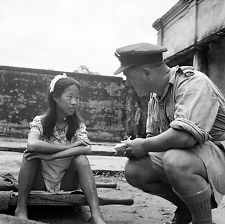
Number of comfort women
Lack of official documentation has made estimation of total numbers of comfort women difficult. Historians have arrived at various estimates by looking at surviving documentation which indicate the ratio of number of soldiers in a particular area to the number of women, as well as looking at replacement rates of the women.[7] Historian Yoshiaki Yoshimi, who conducted the first academic study on the topic that brought the issue into the open, estimated the number between 45,000 and 200,000.[8] Historian Ikuhiko Hata estimated the number more likely around 20,000.[8]
Most international media sources quote that the Japanese secured about 200,000 young women for Japanese military brothels. The BBC quotes "An estimated 200,000 to 300,000 women across Asia, predominantly Korean and Chinese, are believed to have been forced to work as sex slaves in Japanese military brothels."[9]
Countries of origin
Japanese and international historians dispute the numbers that originated from each country. Internationally, the media quotes that most Comfort women originated from Korea and China.[9] According to Kanto Gakuin University professor Hirofumi Hayashi, the majority of the women were from Japan, Korea, and China.[10] Chuo University professor Yoshiaki Yoshimi stated there were about 2000 centers where as many as 200,000 Japanese, Chinese, Korean, Filipino, Taiwanese, Burmese, Indonesian, Dutch, and Australian women were interned.[11]
Nihon University professor Ikuhiko Hata estimated the number of women working in the licensed pleasure quarter was fewer than 20,000. They were 40 percent Japanese, 20 percent Koreans, 10 percent Chinese, with "others" making up the remaining 30 percent. 200,000 might be an overestimation because the total number of government-regulated prostitutes was 170,000 in Japan during World War II.[12] Historian Ikuhiko Hata's study concludes that 40 percent of them came from Japan, 20 percent from Korea, 10 percent from China, and "others" making up the remaining 30 percent. These others came from the Philippines, Taiwan, Dutch East Indies, and other Japanese-occupied countries and regions.[10]
Establishment of comfort women system
Japanese military prostitution
Given the well-organized and open nature of prostitution in Japan, organized prostitution in the Japanese Armed Forces seemed natural.[13] Japanese authorities hoped that providing easily accessible prostitutes for soldiers would improve their morale and, consequentially, the effectiveness of Japanese soldiers in combat. Also, by institutionalizing brothels and placing them under official scrutiny, the government hoped to control the spread of STDs. Military correspondence of Japanese Imperial Army gives evidence of a concern to prevent rape crimes by Japanese soldiers drove the creation and maintenance of comfort stations, with the aim of preventing a rise of hostility among people in occupied areas.[8]
Recruitment
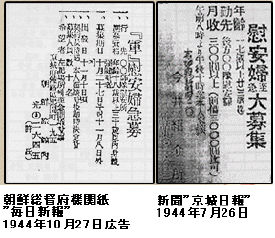
(Right: Keijō nippō, July 26, 1944) "Military Comfort Women Wanted, Urgent!" Age: 17-30. Place of Employment: entertainment for non-frontline unit [obscured]. Monthly Salary: More than 300 yen. (You can receive an advance on salary up to 3000 yen.) From 8 A.M. to 10 P.M., …[obscured]. [Contact at] [Address (unreadable)] Imai [Employment] Registry
In the early stages of the war, Japanese authorities recruited prostitutes through conventional means. Middlemen advertised in newspapers circulating in Japan and the Japanese colonies of Korea, Taiwan, Manchukuo, and mainland China. Many of those who answered the advertisements already worked as prostitutes and offered their services voluntarily. In other cases, parents sold their daughters to the military due to economic hardship. Why the Japanese government ceased using those avenues remains unclear. In any event, the military turned to acquiring comfort women outside mainland Japan, especially from Korea and occupied China. The allegation has been levied that Japanese tricked or defrauded women to join military brothels. A United States Army Force Office report of interviews with 20 comfort women in Burma found the women induced by offers of money, providing them with an opportunity to pay off the family debts. On the basis of those false representations, many girls enlisted for overseas duty, rewarded with advance of a few hundred yen.[14]
In urban areas, conventional advertising through middlemen accompanied the practice of kidnapping. Along the front lines, especially in the countryside where few middlemen ventured, the military often directly demanded that local leaders procure women for the brothels. That situation worsened as the war progressed. Under the strain of the war effort, the military fell desperately short of supplies to Japanese units. Japanese units made up the difference by demanding or looting supplies from the locals. When the locals, especially Chinese, resisted, Japanese soldiers carried out the "Three Alls Policy," which included indiscriminately kidnapping and raping local civilians.[15][16][17]
Treatment of comfort women
Officers of the Japanese Imperial Army took Dutch women by force from prison camps in Java to become forced sex slaves in February 1944. They were systematically beaten and raped day and night in a so called "Comfort Station."[18][4] As a victim of the incident, Jan Ruff-O'Hearn gave testimony to the United States House of Representatives:
Many stories have been told about the horrors, brutalities, suffering and starvation of Dutch women in Japanese prison camps. But one story was never told, the most shameful story of the worst human rights abuse committed by the Japanese during World War II: The story of the “Comfort Women,” the jugun ianfu, and how these women were forcibly seized against their will, to provide sexual services for the Japanese Imperial Army. In the so-called “Comfort Station” I was systematically beaten and raped day and night. Even the Japanese doctor raped me each time he visited the brothel to examine us for venereal disease.[18][4]
According to Unit 731 soldier Yasuji Kaneko, "The women cried out, but it didn't matter to us whether the women lived or died. We were the emperor's soldiers. Whether in military brothels or in the villages, we raped without reluctance."[19] [20] Reports cited that beatings and physical torture happened as common occurrences.[18]
History of the controversy
Yoshida
In 1983, Seiji Yoshida published Watashino sensō hanzai - Chōsenjin Kyōsei Renkō (My War Crimes: The Impressment of Koreans), in which the author confesses to forcibly procuring women from Jeju Island in Korea under the direct order from the Japanese military. In 1991, Asahi Shimbun, one of the major newspapers of Japan, ran a series on comfort women for a year, often regarded as the trigger of the on-going controversy over comfort women in Japan. In that series, the Asahi Shimbun repeatedly published excerpts of his book. Yoshida's confessions have regarded as evidence of "forced comfort women," cited in the U.N. report by Dr. Radhika Coomaraswamy as well.
However, some people doubted Yoshida's "confession" because nobody other than him told of such crimes. When Ikuhiko Hata revisited the villages in South Korea where Yoshida claimed he had abducted many women, nobody confirmed Yoshida's confession, villagers giving accounts contradictory to his confession. When questioned about those contradictions, Yoshida admitted that he had lied. In August 2014, the Asahi Shimbun also retracted articles that the paper had published based on or including information from Yoshida, in large part because of pressure from conservative activists and organizations.[21]
Initial government response and litigation
Initially the Japanese government denied any official connection to the wartime brothels. In June 1990, the Japanese government declared that private contractors ran all brothels. In 1990, the Korean Council for Women Drafted for Military Sexual Slavery filed suit, demanding compensation. Several surviving comfort women also independently filed suit in the Tokyo District Court. The court rejected those suits on grounds such as statute of limitations, the immunity of the State at the time of the act concerned, and non-subjectivity of the individual of international law.[22]
Kono statement
In 1992, the historian Yoshiaki Yoshimi discovered incriminating documents in the archives of Japan's Defense Agency implicating the military's direct involvement in running the brothels (by, for example, selecting the agents who recruited).[11] When the Japanese media on January 12, 1993 published Yoshimi's findings, they caused a sensation and forced the government, represented by Chief Cabinet Secretary, Koichi Kato, to acknowledge some of the facts the same day. On January 17, Prime minister Kiichi Miyazawa presented formal apologies for the suffering of the victims during a trip to South Korea.
On August 4, 1993, Yohei Kono, the Chief Cabinet Secretary of the Japanese government, issued a statement recognizing that "Comfort stations were operated in response to the request of the military of the day," that "The Japanese military was directly or indirectly involved in the establishment and management of the comfort stations and the transfer of the women" and that the women "were recruited in many cases against their own will through coaxing and coercion." The Government of Japan "sincerely apologizes and (expresses its] remorse to all those, irrespective of place of origin, who suffered immeasurable pain and incurable psychological wounds." In that statement, the Government of Japan expressed its "firm determination never to repeat the same mistake and that they would engrave such issue through the study and teaching of history."[23]
Asia Women's Fund
In 1995, Japan set up an "Asia Women's Fund" for atonement in the form of material compensation and to provide each surviving comfort woman with a signed apology from the prime minister, stating
As Prime Minister of Japan, I thus extend anew my most sincere apologies and remorse to all the women who underwent immeasurable and painful experiences and suffered incurable physical and psychological wounds as comfort women. I believe that our country, painfully aware of its moral responsibility, with feelings of apology and remorse, should face up squarely to its past history and accurately convey it to future generations.[24]
Private citizens, businesses, and organizations donated to the fund, not the government, prompting the criticism that the government used that method as a way to deny government responsibility.[20]
U.S. Congressional debate
In 2007, Mike Honda of the United States House of Representatives proposed House Resolution 121 stating that Japan should formally acknowledge, apologize, and accept historical responsibility in a clear and unequivocal manner, refute any claims that the issue of comfort women never occurred, and educate current and future generations "about this horrible crime while following the recommendations of the international community with respect to the `comfort women'."[25]
Abe denial and controversy
On March 2, 2007, Japanese prime minister Shinzo Abe raised the issue again, denying that the military had forced women into sexual slavery during World War II in an orchestrated way. He stated: "The fact is, there is no evidence to prove there was coercion."[26] Before he spoke, a group of Liberal Democratic Party lawmakers also sought to revise Yohei Kono's 1993 apology to former comfort women. Abe's statement provoked a negative reaction from Asian and Western countries. [27]
Wednesday demonstrations in South Korea
Every Wednesday, living comfort women, women's organizations, socio-civic groups, religious groups, and a number of individuals participate in the Wednesday Demonstrations in front of the Japanese Embassy in Seoul, sponsored by “The Korean Council for the Women Drafted for Military Sexual Slavery by Japan (KCWDMSS).” It was first held on January 8, 1992, when Japan's Prime Minister Kiichi Miyazawa visited South Korea. In December 2011, a statue of a young woman was erected in front of the Japanese Embassy to honor the comfort women on the 1,000th Wednesday Demonstration. The Japanese government has repeatedly asked the South Korean government to have the statue taken down, but it has not been removed.
In May 2020, Lee Yong-soo, longtime activist with the Wednesday Demonstrations and one of the youngest comfort women still living, accused the Korean Council for Justice and Remembrance and Yoon Mee-hyang, the former head, of misusing funds and embezzlement. She stated that she had been used for thirty years, and accused the Korean Council of “collecting the money” while putting the comfort women victims on show, comparing them to “bears doing tricks.”[28] As a result, Lee said she would no longer attend the Wednesday demonstrations and called for Yoon Mee-hyang resign from becoming a member of the National Assembly.
Notes
- ↑ Martin Fackler, 2007-03-06 No Apology for Sex Slavery, Japan’s Prime Minister Says The New York Times, March 6, 2007. Retrieved June 2, 2020.
- ↑ Abe questions sex slave 'coercion' BBC News, March 2, 2007. Retrieved June 2, 2020.
- ↑ Japan party probes sex slave use. BBC News, March 8, 2007. Retrieved June 2, 2020.
- ↑ 4.0 4.1 4.2 Norimitsu Onishi, Denial Reopens Wounds of Japan's Ex-Sex Slaves The New York Times, March 8, 2007. Retrieved June 2, 2020.
- ↑ Japanese PM dashes sex slaves' hope of apology Reuters, March 6, 2007. Retrieved June 2, 2020.
- ↑ S. Korea raps Japan over sex slaves BBC News, March 6, 2007. Retrieved June 2, 2020.
- ↑ 7.0 7.1 Akemi Nakamura, Comfort Women: Were they teen-rape slaves or paid pros? The Japan Times, March 20, 2007. Retrieved June 2, 2020.
- ↑ 8.0 8.1 8.2 The "Comfort Women" Issue and the Asian Women's Fund Digital Museum. Retrieved June 2, 2020.
- ↑ 9.0 9.1 Sex slaves put Japan on trial BBC, December 8, 2000. Retrieved June 2, 2020.
- ↑ 10.0 10.1 C. Sarah Soh, Japan's Responsibility Toward Comfort Women Survivors Japan Policy Research Institute, Working Paper No. 77, May 2001. Retrieved June 2, 2020.
- ↑ 11.0 11.1 Yoshiaki Yoshimi, Comfort Women: Sexual Slavery in the Japanese Military during World War II (Columbia University Press, 2002).
- ↑ Ikuhiko Hata, Ianfu to senjo no sei (Comfort women and the sex in the battlefield) (Shinchosha, 1999, ISBN 4106005654).
- ↑ George Hicks, The Comfort Women (London: Allen & Unwin, ISBN 1863737278).
- ↑ Report No. 49: Japanese POW Interrogation on Prostitution U.S. War Information Office. Retrieved June 2, 2020.
- ↑ Akira Fujiwara, (藤原彰) The Three Alls Policy and the Northern Chinese Regional Army (「三光作戦」と北支那方面軍), (Kikan sensô sekinin kenkyû 20, 1998) (in Japanese)
- ↑ Mitsuyoshi Himeta, (姫田光義) Concerning the Three Alls Strategy/Three Alls Policy By the Japanese Forces (日本軍による『三光政策・三光作戦をめぐって』), (Iwanami Bukkuretto, 1996).
- ↑ Herbert P. Bix, Hirohito and the Making of Modern Japan (HarperCollins, 2000, ISBN 006019314X).
- ↑ 18.0 18.1 18.2 Statement of Jan Ruff O’Herne AO, Subcommittee on Asia, Pacific and the Global Environment, Committee on Foreign Affairs, U.S. House of Representatives, February 15, 2007. Retrieved June 2, 2020.
- ↑ 731部隊「コレラ作戦」 (in Japanese) Retrieved June 2, 2020.
- ↑ 20.0 20.1 Hiroko Tabuchi, Japan's Abe: No Proof of WWII Sex Slaves. The Associated Press/The Washington Post, March 1, 2007. Retrieved June 2, 2020.
- ↑ Reiji Yoshida, Asahi Shimbun admits errors in past 'comfort women' stories The Japan Times, August 5, 2014. Retrieved June 2, 2020.
- ↑ Lawsuits brought against Japan by former Korean "comfort women" Columbia Law School, December 6, 1991. Retrieved June 2, 2020.
- ↑ Statement by the Chief Cabinet Secretary Yohei Kono on the result of the study on the issue of "comfort women" Ministry of Foreign Affairs of Japan, August 4, 1993.
- ↑ Yvonne Chang, Japanese Leader Writes Apology to Comfort Women The Washington Post, August 15, 1996. Retrieved June 2, 2020.
- ↑ H.Res. 121 (110th). US House of Representatives, July 30, 2007. Retrieved June 2, 2020.
- ↑ Kinue Tokudome, The Japanese Apology on the "Comfort Women" Cannot Be Considered Official: Interview with Congressman Michael Honda The Asia-Pacific Journal 5(5) May 2, 2007. Retrieved June 2, 2020.
- ↑ Editorial, No Comfort. The New York Times, March 6, 2007. Retrieved June 2, 2020.
- ↑ Sarah Kim, 'Comfort woman' Lee excoriates lawmaker-elect Yoon Korea JoongAng Daily, May 25, 2020. Retrieved June 2, 2020.
References
ISBN links support NWE through referral fees
- Bix, Herbert P. Hirohito and the Making of Modern Japan. HarperCollins, 2000. ISBN 006019314X
- Hata, Ikuhiko. Ianfu to senjo no sei (Comfort women and the sex in the battlefield) Shinchosha, 1999. ISBN 978-4106005657 (in Japanese)
- Henson, Maria Rosa. Comfort Woman: A Filipina's Story of Prostitution and Slavery Under the Japanese Military. Lanham, MD: Rowman & Littlefield Publishers, 1999. ISBN 0847691497
- Hicks, George L. The Comfort Women: Japan's Brutal Regime of Enforced Prostitution in the Second World War. New York: W.W. Norton & Co., 1997. ISBN 0393316947
- Keller, Nora Okja. Comfort Woman. London: Penguin, 1998. ISBN 0140263357
- Kim-Gibson, Dai Sil. Silence Broken: Korean Comfort Women. Mid-Prairie Books, 1999. ISBN 0931209889
- Molasky, Michael S. American Occupation of Japan and Okinawa. Routledge, 1999. ISBN 0415191947
- Morris, Narrelle. Review of Japan's Comfort Women: Sexual Slavery and Prostitution During World War II and the US Occupation Intersections: Gender, History and Culture in the Asian Context 9 (August 2003). Retrieved June 2, 2020.
- Nakamura, Akemi. Comfort Women: Were they teen-rape slaves or paid pros? The Japan Times, March 20, 2007. Retrieved June 2, 2020.
- Schellstede, Sangmie Choi. Comfort Women Speak: Testimony by Sex Slaves of the Japanese Military. Holmes & Meier Publishers, 2000. ISBN 0841914133.
- Soh, C. Sarah. The Comfort Women: Sexual Violence and Postcolonial Memory in Korea and Japan. (Worlds of Desire: The Chicago Series on Sexuality, Gender, and Culture) University Of Chicago Press, 2009. ISBN 0226767779.
- Tanaka, Yuki. Japan's Comfort Women: Sexual Slavery and Prostitution During World War II and the US Occupation. London, Routledge: 2002. ISBN 0415194016.
- Wakabayashi, Bob Tadashii. Review: Comfort Women: Beyond Litigious Feminism Monumenta Nipponica 58(2) (Summer, 2003): 223-258.
- Yoshida, Seiji. 私の戦争犯罪―朝鮮人強制連行 (My war crime - the forced transport of Koreans) Tokyo: San'ichi Shobō 1983.
- Yoshimi, Yoshiaki. Comfort Women: Sexual Slavery in the Japanese Military During World War II. Columbia University Press, 2001. ISBN 023112032X.
External Links
All links retrieved June 2, 2020.
- Closing of the Asian Women's Fund.
- Comfort-Women.org.
- Comfort Woman Picture Gallery The Seoul Times.
- The Comfort Women project 2008.
- Responsibility Toward Comfort Women Survivors Japan Policy Research Institute Working Paper 77.
- Japan's Comfort Women, Theirs and Ours Book review, Japan Policy Research Institute Critique 9:2.
- Journal of Asian American Studies 6:1, Feb 2003, issue on American studies of comfort women, Kandice Chuh, ed.
- Statement by Prime Minister Tomiichi Murayama on the occasion of the establishment of the "Asian Women's Fund" Japan Ministry of Foreign Affairs, 1995.
- Letter from Prime Minister Junichiro Koizumi to the former comfort women Japan Ministry of Foreign Affairs, 2001.
- Report No. 49: Japanese Prisoners of War Interrogation on Prostitution United States Office of War Information, 1944.
- The Comfort Women Controversy: Not Over Yet by Thomas J. Ward and William B. Lay, 2016.
- Fabricated "Comfort Women" by Rev. Arimasa Kubo (Japanese Christian pastor and writer)
Western Europe · Eastern Europe · China · Africa · Mediterranean · Asia and the Pacific · Atlantic |
|||||
Major participants |
Timeline |
Aspects |
|||
|
Principal co-belligerents in italics. |
Prelude 1939 1940 1941 1942 |
1943 1944 1945 • more military engagements Aftermath |
• Attacks on North America Civilian impact and atrocities |
||
| Allies | Axis | ||||
|
at war from 1937 entered 1939 entered 1940 |
entered 1941 entered 1942 entered 1943 entered 1944 • others |
at war from 1937 entered 1939 entered 1940 entered 1941 entered 1942 • others |
|||
| Resistance movements
Austria · Baltic1 · Czechoslovakia · Denmark · Ethiopia · France · Germany · Greece · Italy · Jewish · Netherlands · Norway · Poland · Thailand · USSR · Ukraine2 · Vietnam · Yugoslavia · others |
|||||
1 Anti-Soviet. |
|||||
Credits
New World Encyclopedia writers and editors rewrote and completed the Wikipedia article in accordance with New World Encyclopedia standards. This article abides by terms of the Creative Commons CC-by-sa 3.0 License (CC-by-sa), which may be used and disseminated with proper attribution. Credit is due under the terms of this license that can reference both the New World Encyclopedia contributors and the selfless volunteer contributors of the Wikimedia Foundation. To cite this article click here for a list of acceptable citing formats.The history of earlier contributions by wikipedians is accessible to researchers here:
The history of this article since it was imported to New World Encyclopedia:
Note: Some restrictions may apply to use of individual images which are separately licensed.
↧ Download as ZWI file | Last modified: 02/04/2023 04:50:37 | 9 views
☰ Source: https://www.newworldencyclopedia.org/entry/Comfort_women | License: CC BY-SA 3.0
 ZWI signed:
ZWI signed: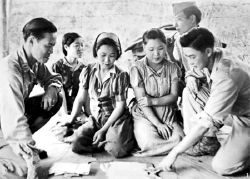
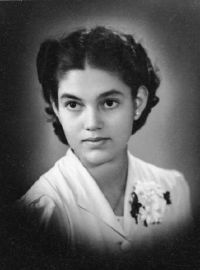
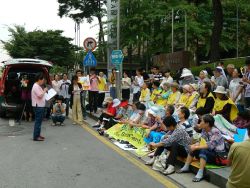
 KSF
KSF